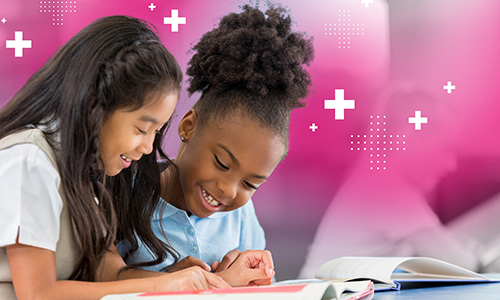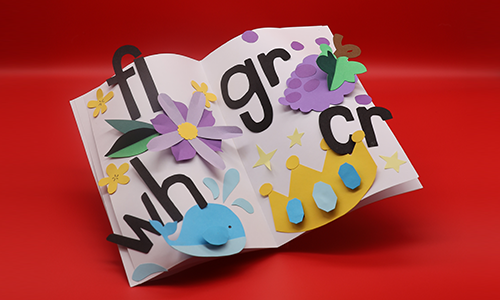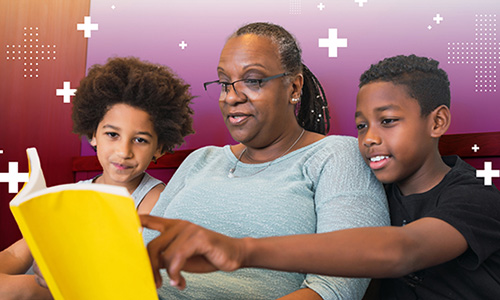 Every child’s literacy journey is unique. Some take off like rockets, while others need a bit more time and support to find their rhythm. No matter where they are, the goal is the same: to help kids become confident, capable, and joyful readers. Effective literacy instruction is built on a strong foundation of explicit, systematic teaching in the core components of phonological awareness, phonics, fluency, vocabulary, and comprehension. The right literacy instruction resources are invaluable when supporting children on their journey.
Every child’s literacy journey is unique. Some take off like rockets, while others need a bit more time and support to find their rhythm. No matter where they are, the goal is the same: to help kids become confident, capable, and joyful readers. Effective literacy instruction is built on a strong foundation of explicit, systematic teaching in the core components of phonological awareness, phonics, fluency, vocabulary, and comprehension. The right literacy instruction resources are invaluable when supporting children on their journey.
Teachers, bookmark this post for later reference, as we explore the literacy milestones and challenges for each age group. You’ll find practical, hands-on activities linked with videos and printables from the highly respected Florida Center for Reading Research. These are the very resources provided in our custom MAP® Reading Fluency™ reports. (Note that all are welcome to print copies of the resources as long as modifications are not made, the materials are used for non-profit educational purposes only, and a copyright line listing both the Florida Department of Education and the Florida Center for Reading Research is included. The resources may be linked to but not reposted, reproduced, modified, or copied to other sites. For questions about the use of these materials, contact The Florida Center for Reading Research at fcrr@fcrr.org.)
Whether you’re guiding emerging readers in a clapping game, helping older students refine their comprehension, or equipping families to continue the learning at home, this reference list of literacy terms and strategies will support readers of all ages. Before we break into grade levels, here are some FCRR quick links for teachers and families you can start with:
- Grade-level guides for supporting family involvement
- K–3 strategies for supporting your child’s reading at home
- Spanish student center activities
And if you’re ready to learn in person or online, our comprehensive literacy professional learning suite can be customized to fit your school, whether it’s a one-and-done workshop or a holistic solution. Here are some literacy-specific workshop opportunities from us here at NWEA:
- Grades K–2: Building fluent readers
- Grades K–5: Cultivating comprehension and knowledge
- Grades K–5: Advanced word recognition
- MAP Reading Fluency: Leveraging data to build fluent reading strategies
Pre-kindergarten: Building the foundation for literacy
Pre-K is where the earliest building blocks of literacy are laid. Students at this stage are developing oral language and listening comprehension skills while also beginning to explore print concepts. The range of abilities is vast; some children enter with strong vocabularies and exposure to books, while others may have had limited literacy experiences. Teachers face the challenge of balancing playful, exploratory activities with intentional, structured language and literacy support.
Key literacy concepts
- Phonological awareness: The ability to recognize and manipulate the sounds of spoken language
- Oral language development: Expanding vocabulary and sentence structures through teacher-led conversation, storytelling, and book reading
- Print awareness: Understanding that print carries meaning, learning book-handling skills, and recognizing some letters
Effective activities
- Sound play games: Rhyming games (e.g., coming up with a list of words that rhyme with “cat”), alliteration activities (e.g., exploring sentences like “Silly Sally sings songs”), and segmenting words into syllables using clapping
- Storytime with interactive discussion: Reading books aloud while asking open-ended questions (e.g., “What do you think will happen next?”) and asking students to connect what they’ve heard with the images on the page; this builds comprehension and oral language skills
- Letter and name exploration: Engaging children with activities where they identify and form the letters in their names using things like shaving cream, playdough, magnetic letters, or stamps
View all FCRR literacy instruction resources for pre-K.
Kindergarten and first grade: Cracking the code
In these grades, students transition to more formalized instruction in phonics, which focuses on the relationship between letters and sounds. While some students arrive already recognizing sight words and blending simple sounds, others may need extra support with letter recognition. The range of skills is wide, making differentiated instruction essential.
Key literacy concepts
- Phonological awareness: Continuing to develop rhyme awareness, syllable segmentation, and beginning sound isolation
- Phonics: Explicit instruction on letter-sound correspondences and blending sounds to form words
- Fluency: Beginning to develop accuracy and automaticity with decoding simple words
- Vocabulary: Introducing high-frequency words and building oral vocabulary through read-alouds
Effective activities
- Blending and segmenting games: Using manipulatives (e.g., colored chips) to represent sounds in CVC (consonant-vowel-consonant) words (e.g., students tap out each sound as they blend or segment words)
- Decodable texts: Reading books that follow taught phonics patterns (e.g., short vowel sounds) reinforces decoding skills
- Interactive writing: Teachers and students co-create simple sentences, helping children practice letter formation and sound-spelling relationships
- High-frequency word games: Games like sight-word bingo and word hunts promote recognition of common words.
View all FCRR literacy instruction resources for grades K–1.
Second and third grade: Moving toward fluency and comprehension
By second and third grade, most students are moving from learning to read toward reading to learn. However, there is still a wide range of skills: some students are decoding fluently, while others may still be working on basic phonics. This stage marks a crucial shift toward building fluency, expanding vocabulary, and strengthening comprehension skills.
Key literacy concepts
- Fluency: Developing speed, accuracy, and expression when reading aloud
- Vocabulary: Expanding word knowledge through exposure to rich texts and direct instruction of unfamiliar words
- Comprehension: Strengthening the ability to understand, interpret, and discuss texts, including making inferences
- Morphological awareness: Recognizing prefixes, suffixes, and root words, which supports decoding and vocabulary growth
Effective activities
- Repeated reading: Practicing short passages multiple times to improve fluency and expression
- Vocabulary in context: Pre-teaching key vocabulary words before reading a text and providing opportunities for students to use the words in speaking and writing
- Comprehension strategies: Using graphic organizers (e.g., story maps and Venn diagrams) to help students visualize and organize their thinking
- Word sorts and word building: Sorting words by spelling patterns or building new words by adding prefixes or suffixes helps reinforce morphology and phonics skills
View all FCRR literacy instruction resources for grades 2–3.
Fourth and fifth grade: Refining comprehension and reading across content areas
In the upper elementary grades, students are expected to read increasingly complex texts and apply their literacy skills across subjects. However, some students may still benefit from support with decoding, which can hinder comprehension. The challenge for teachers is to support these readers while continuing to build vocabulary, comprehension strategies, and text analysis skills.
Key literacy concepts
- Fluency: Continued focus on smooth, expressive reading, especially when tackling longer, more complex texts
- Vocabulary: Growing academic and domain-specific vocabulary through content-area reading
- Comprehension: Strengthening skills such as summarizing, making inferences, and analyzing the author’s purpose
- Text structure awareness: Recognizing how different types of texts (narrative, informational, persuasive) are organized
Effective activities
- Close reading: Engaging students in multiple readings of the same text to analyze meaning, structure, and language
- Text annotation: Encouraging students to underline, highlight, and make margin notes to deepen comprehension; Color coding goes a long way here
- Collaborative discussions: Structured group discussions where students use evidence from the text to support their ideas
- Vocabulary journals: Having students create personal vocabulary journals where they record new words and definitions and also use the words in original sentences (e.g., a scrapbook where students cut words from newspapers, magazines, or recycling bin items and glue them in)
View all FCRR literacy instruction resources for grades 4–5.
Partnering for lifelong literacy
Literacy doesn’t begin and end with one grade level; it’s a journey that builds year over year, skill by skill. With the right tools, resources, and intentional strategies, educators can meet each student exactly where they are and help them grow into thoughtful, fluent readers.
Bookmark this guide, share it with colleagues, and return to it often as your students progress. When teachers and families work together with purpose, we give children not only the ability to read but also the confidence to thrive in every subject, every year and beyond.






